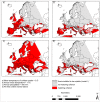Aedes albopictus and Its Environmental Limits in Europe
- PMID: 27603669
- PMCID: PMC5014377
- DOI: 10.1371/journal.pone.0162116
Aedes albopictus and Its Environmental Limits in Europe
Abstract
The Asian tiger mosquito Aedes albopictus, native to South East Asia, is listed as one of the worst invasive vector species worldwide. In Europe the species is currently restricted to Southern Europe, but due to the ongoing climate change, Ae. albopictus is expected to expand its potential range further northwards. In addition to modelling the habitat suitability for Ae. albopictus under current and future climatic conditions in Europe by means of the maximum entropy approach, we here focused on the drivers of the habitat suitability prediction. We explored the most limiting factors for Aedes albopictus in Europe under current and future climatic conditions, a method which has been neglected in species distribution modelling so far. Ae. albopictus is one of the best-studied mosquito species, which allowed us to evaluate the applied Maxent approach for most limiting factor mapping. We identified three key limiting factors for Ae. albopictus in Europe under current climatic conditions: winter temperature in Eastern Europe, summer temperature in Southern Europe. Model findings were in good accordance with commonly known establishment thresholds in Europe based on climate chamber experiments and derived from the geographical distribution of the species. Under future climatic conditions low winter temperature were modelled to remain the most limiting factor in Eastern Europe, whereas in Central Europe annual mean temperature and summer temperatures were modelled to be replaced by summer precipitation, respectively, as most limiting factors. Changes in the climatic conditions in terms of the identified key limiting factors will be of great relevance regarding the invasive potential of the Ae. albopictus. Thus, our results may help to understand the key drivers of the suggested range expansion under climate change and may help to improve monitoring programmes. The applied approach of investigating limiting factors has proven to yield valuable results and may also provide valuable insights into the drivers of the prediction of current and future distribution of other species. This might be particularly interesting for other vector species that are of increasing public health concerns.
Conflict of interest statement
The authors have declared that no competing interests exist.
Figures





Similar articles
-
Aedes albopictus and Aedes japonicus - two invasive mosquito species with different temperature niches in Europe.Parasit Vectors. 2016 Nov 4;9(1):573. doi: 10.1186/s13071-016-1853-2. Parasit Vectors. 2016. PMID: 27814747 Free PMC article.
-
Recent and projected future climatic suitability of North America for the Asian tiger mosquito Aedes albopictus.Parasit Vectors. 2014 Dec 2;7:532. doi: 10.1186/s13071-014-0532-4. Parasit Vectors. 2014. PMID: 25441177 Free PMC article.
-
Seasonality modeling of the distribution of Aedes albopictus in China based on climatic and environmental suitability.Infect Dis Poverty. 2019 Dec 3;8(1):98. doi: 10.1186/s40249-019-0612-y. Infect Dis Poverty. 2019. PMID: 31791409 Free PMC article.
-
The role of environmental variables on Aedes albopictus biology and chikungunya epidemiology.Pathog Glob Health. 2013 Jul;107(5):224-41. doi: 10.1179/2047773213Y.0000000100. Pathog Glob Health. 2013. PMID: 23916332 Free PMC article. Review.
-
Climatic suitability of Aedes albopictus in Europe referring to climate change projections: comparison of mechanistic and correlative niche modelling approaches.Euro Surveill. 2014 Feb 13;19(6):20696. doi: 10.2807/1560-7917.es2014.19.6.20696. Euro Surveill. 2014. PMID: 24556349 Review.
Cited by
-
Ticks on the move-climate change-induced range shifts of three tick species in Europe: current and future habitat suitability for Ixodes ricinus in comparison with Dermacentor reticulatus and Dermacentor marginatus.Parasitol Res. 2022 Aug;121(8):2241-2252. doi: 10.1007/s00436-022-07556-x. Epub 2022 Jun 1. Parasitol Res. 2022. PMID: 35641833 Free PMC article.
-
Investigation of temperature conditions in Swiss urban and suburban microhabitats for the overwintering suitability of diapausing Aedes albopictus eggs.Parasit Vectors. 2018 Mar 27;11(1):212. doi: 10.1186/s13071-018-2803-y. Parasit Vectors. 2018. PMID: 29587850 Free PMC article.
-
The effects of microclimatic winter conditions in urban areas on the risk of establishment for Aedes albopictus.Sci Rep. 2022 Sep 24;12(1):15967. doi: 10.1038/s41598-022-20436-9. Sci Rep. 2022. PMID: 36153403 Free PMC article.
-
Demographic and environmental factors associated with the distribution of Aedes albopictus in Cameroon.Med Vet Entomol. 2023 Mar;37(1):143-151. doi: 10.1111/mve.12619. Epub 2022 Oct 20. Med Vet Entomol. 2023. PMID: 36264191 Free PMC article.
-
Blessing and curse of bioclimatic variables: A comparison of different calculation schemes and datasets for species distribution modeling within the extended Mediterranean area.Ecol Evol. 2023 Sep 28;13(10):e10553. doi: 10.1002/ece3.10553. eCollection 2023 Oct. Ecol Evol. 2023. PMID: 37780091 Free PMC article.
References
-
- Caminade C, Medlock JM, Ducheyne E, McIntyre KM, Leach S, Matthew B et al. (2012) Suitability of European climate for the Asian tiger mosquito Aedes albopictus: recent trends and future scenarios. Journal of the Royal Society, Interface / the Royal Society 9 (75): 2708–2717. 10.1098/rsif.2012.0138 - DOI - PMC - PubMed
-
- Medlock JM, Avenell D, Barrass I, Leach S (2006) Analysis of the potential for survival and seasonal activity of Aedes albopictus (Diptera. Culicidae) in the United Kingdom. Journal of Vector Ecology 31 (2): 292–304. - PubMed
MeSH terms
LinkOut - more resources
Full Text Sources
Other Literature Sources

